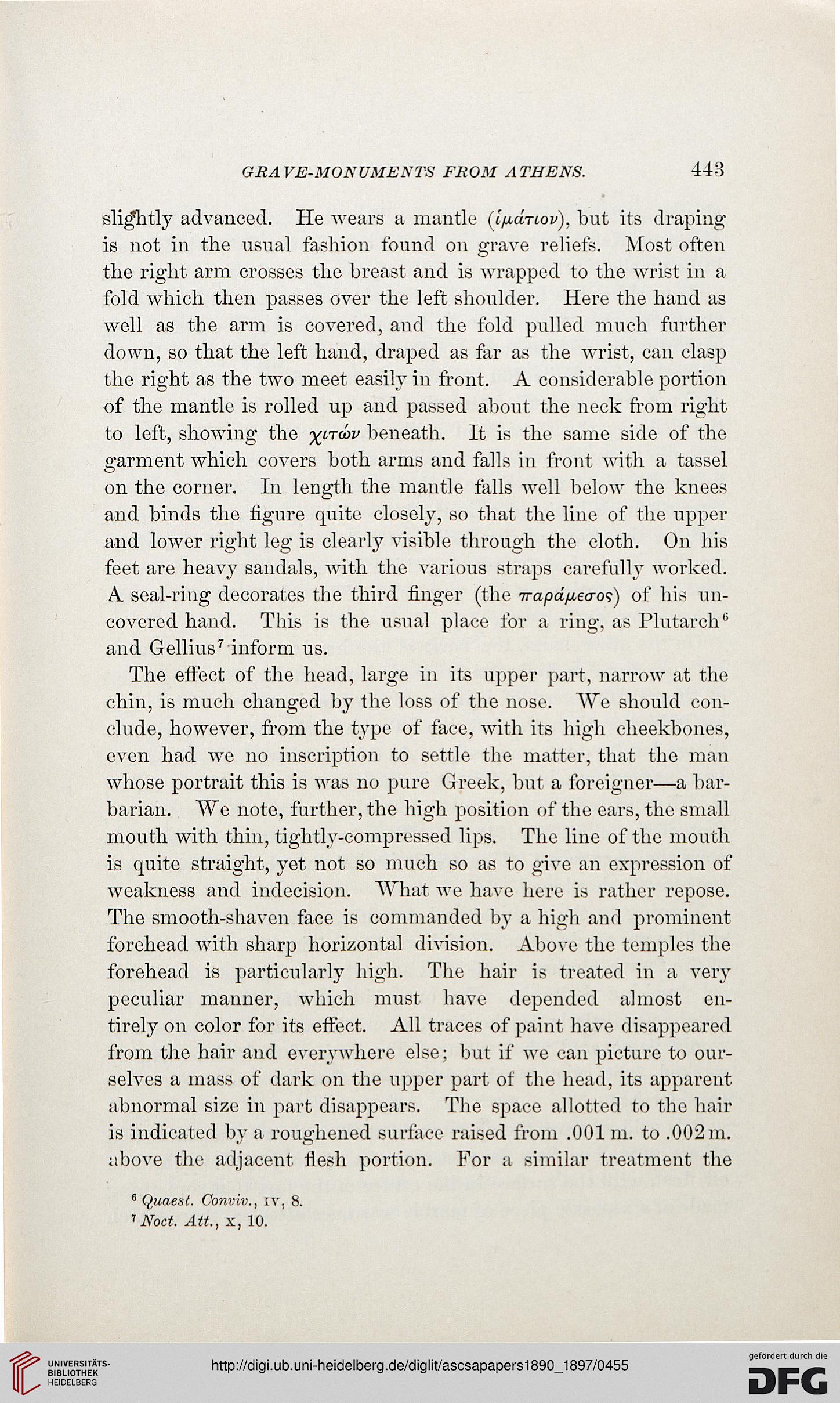GRAVE-MONUMENTS FROM ATHENS.
443
slightly advanced. He wears a mantle (1/x.d.Tiov), but its draping
is not in the usual fashion found on grave reliefs. Most often
the right arm crosses the breast and is wrapped to the wrist in a
fold which then passes over the left shoulder. Here the hand as
well as the arm is covered, and the fold pulled much further
down, so that the left hand, draped as far as the wrist, can clasp
the right as the two meet easily in front. A considerable portion
of the mantle is rolled up and passed about the neck from right
to left, showing the ^ito>v beneath. It is the same side of the
garment which covers both arms and falls in front with a tassel
on the corner. In length the mantle falls well below the knees
and binds the figure quite closely, so that the line of the upper
and lower right leg is clearly visible through the cloth. On his
feet are heavy sandals, with the various straps carefully worked.
A. seal-ring decorates the third finger (the Trapdfieaos) of his un-
covered hand. This is the usual place for a ring, as Plutarch0
and Gellius7 inform us.
The effect of the head, large in its upper part, narrow at the
chin, is much changed by the loss of the nose. We should con-
clude, however, from the type of face, with its high cheekbones,
even had we no inscription to settle the matter, that the man
whose portrait this is was no pure Greek, but a foreigner—a bar-
barian. We note, further, the high position of the ears, the small
mouth with thin, tightly-compressed lips. The line of the mouth
is quite straight, yet not so much so as to give an expression of
weakness and indecision. What we have here is rather repose.
The smooth-shaven face is commanded by a high and prominent
forehead with sharp horizontal division. Above the temples the
forehead is particularly high. The hair is treated in a very
peculiar manner, which must have depended almost en-
tirely on color for its effect. All traces of paint have disappeared
from the hair and everywhere else; but if we can picture to our-
selves a mass of dark on the upper part of the head, its apparent
abnormal size in part disappears. The space allotted to the hair
is indicated by a roughened surface raised from .001 m. to .002 m.
above the adjacent flesh portion. For a similar treatment the
8 Quaest. Conviv., tv, 8.
7 Noct. Att., x, 10.
443
slightly advanced. He wears a mantle (1/x.d.Tiov), but its draping
is not in the usual fashion found on grave reliefs. Most often
the right arm crosses the breast and is wrapped to the wrist in a
fold which then passes over the left shoulder. Here the hand as
well as the arm is covered, and the fold pulled much further
down, so that the left hand, draped as far as the wrist, can clasp
the right as the two meet easily in front. A considerable portion
of the mantle is rolled up and passed about the neck from right
to left, showing the ^ito>v beneath. It is the same side of the
garment which covers both arms and falls in front with a tassel
on the corner. In length the mantle falls well below the knees
and binds the figure quite closely, so that the line of the upper
and lower right leg is clearly visible through the cloth. On his
feet are heavy sandals, with the various straps carefully worked.
A. seal-ring decorates the third finger (the Trapdfieaos) of his un-
covered hand. This is the usual place for a ring, as Plutarch0
and Gellius7 inform us.
The effect of the head, large in its upper part, narrow at the
chin, is much changed by the loss of the nose. We should con-
clude, however, from the type of face, with its high cheekbones,
even had we no inscription to settle the matter, that the man
whose portrait this is was no pure Greek, but a foreigner—a bar-
barian. We note, further, the high position of the ears, the small
mouth with thin, tightly-compressed lips. The line of the mouth
is quite straight, yet not so much so as to give an expression of
weakness and indecision. What we have here is rather repose.
The smooth-shaven face is commanded by a high and prominent
forehead with sharp horizontal division. Above the temples the
forehead is particularly high. The hair is treated in a very
peculiar manner, which must have depended almost en-
tirely on color for its effect. All traces of paint have disappeared
from the hair and everywhere else; but if we can picture to our-
selves a mass of dark on the upper part of the head, its apparent
abnormal size in part disappears. The space allotted to the hair
is indicated by a roughened surface raised from .001 m. to .002 m.
above the adjacent flesh portion. For a similar treatment the
8 Quaest. Conviv., tv, 8.
7 Noct. Att., x, 10.




